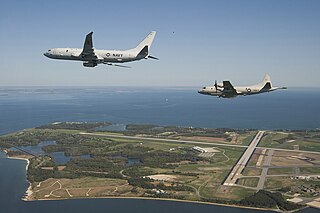
Stephen Scot Oswald is an American former pilot and NASA astronaut.

Alfred Melville Pride was a United States Navy admiral and pioneer naval aviator, who distinguished himself during World War II as an aircraft carrier commander.

Naval Air Station Patuxent River, also known as NAS Pax River, is a United States naval air station located in St. Mary’s County, Maryland, on the Chesapeake Bay near the mouth of the Patuxent River.

The Naval Air Systems Command (NAVAIR) provides materiel support for aircraft and airborne weapon systems for the United States Navy. It is one of the Echelon II Navy systems commands (SYSCOM), and was established in 1966 as the successor to the Navy's Bureau of Naval Weapons.

Richard Chester Macke was a naval aviator and a former rear admiral in the United States Navy. He last served as Commander of United States Pacific Command (USPACOM) from July 19, 1994, until January 31, 1996. After his navy career, Macke served as a vice president of Wheat International Communications Corporation.

Rodney Paul Rempt is a retired Vice Admiral of the United States Navy who served as the 59th Superintendent of the U.S. Naval Academy from 2003 to 2007.

Lillian Elaine Fishburne was the first African-American female to hold the rank of Rear Admiral (RDML) in the United States Navy. She was appointed to the rank of Rear Admiral by President of the United States Bill Clinton and was officially promoted on February 1, 1998. Fishburne retired from the Navy in February 2001.

Rear Admiral Matthew Lewis Klunder was the Chief of Naval Research at the Office of Naval Research in Arlington, Virginia from 2011 to 2014. In July 2010, Klunder reported as director of Intelligence, Surveillance and Reconnaissance Capabilities Division, OPNAV N2/N6F2 following his assignment as the 83rd Commandant of Midshipmen of the United States Naval Academy.
Naval Air Warfare Center is a research organization within Naval Air Systems Command to test and evaluate air warfare for the United States Navy. The center combines the following divisions:

Vice Admiral Walter Black Massenburg is a retired American Navy admiral and former commander of the Naval Air Systems Command in Patuxent River, Maryland.

The Naval Sea Systems Command (NAVSEA) is the largest of the United States Navy's five "systems commands," or materiel organizations. From a physical perspective, NAVSEA has four shipyards for shipbuilding, conversion, and repair, ten "warfare centers", the NAVSEA headquarters, located at the Washington Navy Yard, in Washington D.C., and other locations in 15 states and 3 overseas continents.

Rear Admiral Craig Eugene Steidle, USN, Ret., served as the first associate administrator of the Office of Exploration Systems at NASA, an organization formed to implement NASA's human exploration of the solar system as announced in the Vision for Space Exploration. Admiral Steidle also served as program manager of the Joint Strike Fighter Program. He is currently serving as a distinguished visiting professor in Aerospace Engineering at the U.S. Naval Academy.

Kenneth Stanley Reightler Jr. is a former NASA astronaut.

Brent William Scott is a retired United States Navy rear admiral and chaplain who last served as the 27th Chief of Chaplains of the United States Navy. He previously served as the 19th Chaplain of the United States Marine Corps and the Deputy Chief of Navy Chaplains.

Cindy Louise Jaynes is an American retired rear-admiral. An aeronautics maintenance specialist, she managed several programs relating to US Navy aircraft. Jaynes became the first female flag officer in Naval Air Systems Command when she was promoted to rear-admiral on 1 August 2012. She retired from the US Navy on 1 May 2016.

The Naval Air Systems Command Program Executive Offices(PEOs) are organizations responsible for the prototyping, procurement, and fielding of naval air equipment. Their mission is to develop, acquire, field and sustain affordable and integrated state of the art equipment for the Navy.

Daniel P. Martin is a United States Navy rear admiral and naval aviator who has served as the commander of Naval Safety Command since July 1, 2024. He most recently served as the director of maritime operations of the United States Pacific Fleet from 2022 to 2024. He served as the commander of Carrier Strike Group 1 from 2021 to 2022. He previously served as senior military assistant to the Assistant Secretary of State for Political-Military Affairs. In earlier command tours, he commanded Carrier Air Wing 8 from June 2015 to 2016 and Strike Fighter Squadron 37 from 2010 to 2011.

Carl Paul Chebi is a United States Navy vice admiral who serves as the commander of Naval Air Systems Command since September 9, 2021. He most recently served as the Deputy Program Executive Officer of the F-35 Lightning II Joint Program Office from 30 September 2019 to 9 September 2021. Previously, he served as the Program Executive Officer for Command, Control, Communications, Computers, and Intelligence (C4I) and Space Systems of the Naval Information Warfare Systems Command from 2017 to 2019.

Michael Charles Manazir, also known as Rear Admiral Mike Manazir, is a retired United States Navy two-star admiral who transitioned to civilian life from duty as the deputy chief of naval operations for warfare systems on July 7, 2017.

















